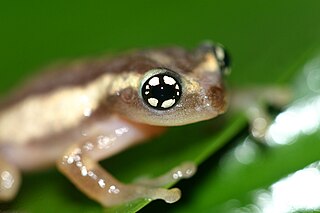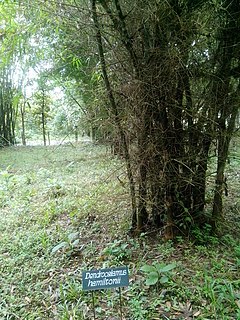
Bamboos are a diverse group of evergreen perennial flowering plants making up the subfamily Bambusoideae of the grass family Poaceae. Giant bamboos are the largest members of the grass family. The origin of the word "bamboo" is uncertain, but it probably comes from the Dutch or Portuguese language, which originally borrowed it from Malay or Kannada.

Oreobambos buchwaldii is the sole representative of Oreobambos, a monotypic African genus of bamboo, most closely related to the large genus Bambusa from tropical Asia and America. It is large and perennial with arching stems up to 20 m. high, growing in isolated clumps, in forest clearings and swamp forest, and along streams, at altitudes of 300–2000 m. It occurs along the tropical east of Africa in eastern DR Congo, Burundi, Kenya, Uganda, Tanzania, Mozambique, Malawi, Zimbabwe and Zambia. This is one of only a handful of indigenous African bamboos.

Polytrichum commune is a species of moss found in many regions with high humidity and rainfall. The species can be exceptionally tall for a moss with stems often exceeding 30 cm (12 in) though rarely reaching 70 cm (27.5 in), but it is most commonly found at shorter lengths of 5 to 10 cm. It is widely distributed throughout temperate and boreal latitudes in the Northern Hemisphere and also found in Mexico, several Pacific Islands including New Zealand, and also in Australia. It typically grows in bogs, wet heathland and along forest streams.

Bambusa vulgaris, common bamboo, is an open-clump type bamboo species. It is native to Indochina and to the province of Yunnan in southern China, but it has been widely cultivated in many other places and has become naturalized in several regions. Among bamboo species, it is one of the largest and most easily recognized.
Arundinaria appalachiana, commonly known as hill cane, is a woody bamboo native to the Appalachian Mountains in the southeastern United States. The plant was elevated to the species level in 2006 based on new morphological and genetic information and was previously treated as a variety of Arundinaria tecta. As a relatively small member of its genus, it usually only attains heights of 0.5 to 1.0 metre with an either dense or diffuse habit. It is one of only three temperate species of bamboo native to North America. Hill cane is common on dry to mesic sites on upland slopes, bluffs and ridges in oak-hickory forests. In contrast to its sympatric relatives, Arundinaria gigantea typically appears along perennial streams, while A. tecta is found in swamps and other very wet areas.

Bambusa tulda, or Indian timber bamboo, is considered to be one of the most useful of bamboo species. It is native to the Indian subcontinent, Indochina, Tibet, and Yunnan, and naturalized in Iraq, Puerto Rico, and parts of South America.

Phyllostachys rubromarginata, the reddish bamboo or red margin bamboo, is a species of Phyllostachys bamboo, native to Central China, specifically Guangxi and Guizhou.

Raorchestes ochlandrae is a species of shrub frog in the family Rhacophoridae. It is endemic to the Western Ghats, India. This species of the oriental shrub frog was first described from Kakkayam Reserve Forest of Calicut district, Kerala state, in the southern Western Ghats in 2007 but has since been recorded at many other sites along the Western Ghats. The specific name ochlandrae refers to microhabitat of the species, bamboo Ochlandra setigera.

Dendrocalamus strictus is a bamboo species belonging to the Dendrocalamus genus. The culms (stems) are often solid. Common names include male bamboo, solid bamboo, and Calcutta bamboo.

Bambusa bambos, the giant thorny bamboo, Indian thorny bamboo, spiny bamboo, or thorny bamboo, is a species of clumping bamboo native to southern Asia. It is also naturalized in Seychelles, Central America, West Indies, Java, Malaysia, Maluku, and the Philippines.

Phyllostachys bambusoides, commonly called madake, giant timber bamboo, or Japanese timber bamboo, is a species of flowering plant in the bamboo subfamily of the grass family Poaceae, native to China, and possibly also to Japan.

Dendrocalamus asper, also known as giant bamboo, or dragon bamboo, is a giant tropical, dense-clumping species native to Southeast Asia. Due to its common occurrence across Asia and its attractive features as well as ease of harvesting, this species has been introduced widely across Latin America and Africa. It is a sympodial or clumping bamboo that does not show lateral growth and therefore has no invasive properties.

Dendrocalamus hamiltonii, or Hamilton's bamboo, is a species of bamboo, 12–15 cm in diameter and growing up to 15–18 m in height, found in South Asian countries such as, India, Sri Lanka, Bhutan, Nepal, Pakistan, and far eastern China.
Dendrocalamus giganteus, commonly known as giant bamboo, is a giant tropical and subtropical, dense-clumping species native to Southeast Asia. It is one of the largest bamboo species in the world.
Neololeba atra, the black bamboo, is a species of tropical Asian, Australian, and Papuasian bamboos in the grass family Poaceae.

Bambusa polymorpha, or Burmese bamboo, is a species of clumping bamboo native to Bangladesh, Laos, Myanmar, Thailand, Sri Lanka, Java, Cuba, Puerto Rico, and Ecuador.
Dendrocalamus longispathus, the long-sheath bamboo, is a bamboo species which grows up to 20 m tall. It is native to Bangladesh, Myanmar, and Thailand. It has now become an exotic species all over the South Asia.

Gigantochloa atter, the black bamboo, sweet bamboo, or giant atter, is a bamboo species belonging to the genus Gigantochloa. It grows up to 20 m tall. It is native to Island Southeast Asia, but has become naturalized all over the South Asia.
Melocanna baccifera is one of two bamboo species belonging to the Melocanna genus. It grows up to 10–25 m tall. It is native to Bangladesh, Myanmar, India, and Thailand.

Thyrsostachys siamensis is one of two bamboo species belonging to the genus Thyrsostachys. It grows up to 7 to 13m tall. It is native to Yunnan, Myanmar, Laos, Thailand, Vietnam and naturalised in Sri Lanka, Bangladesh, Malaysia. The plant is also known as long-sheath bamboo, monastery bamboo, Thai bamboo, Thai umbrella bamboo, umbrella bamboo, and umbrella-handle bamboo.














